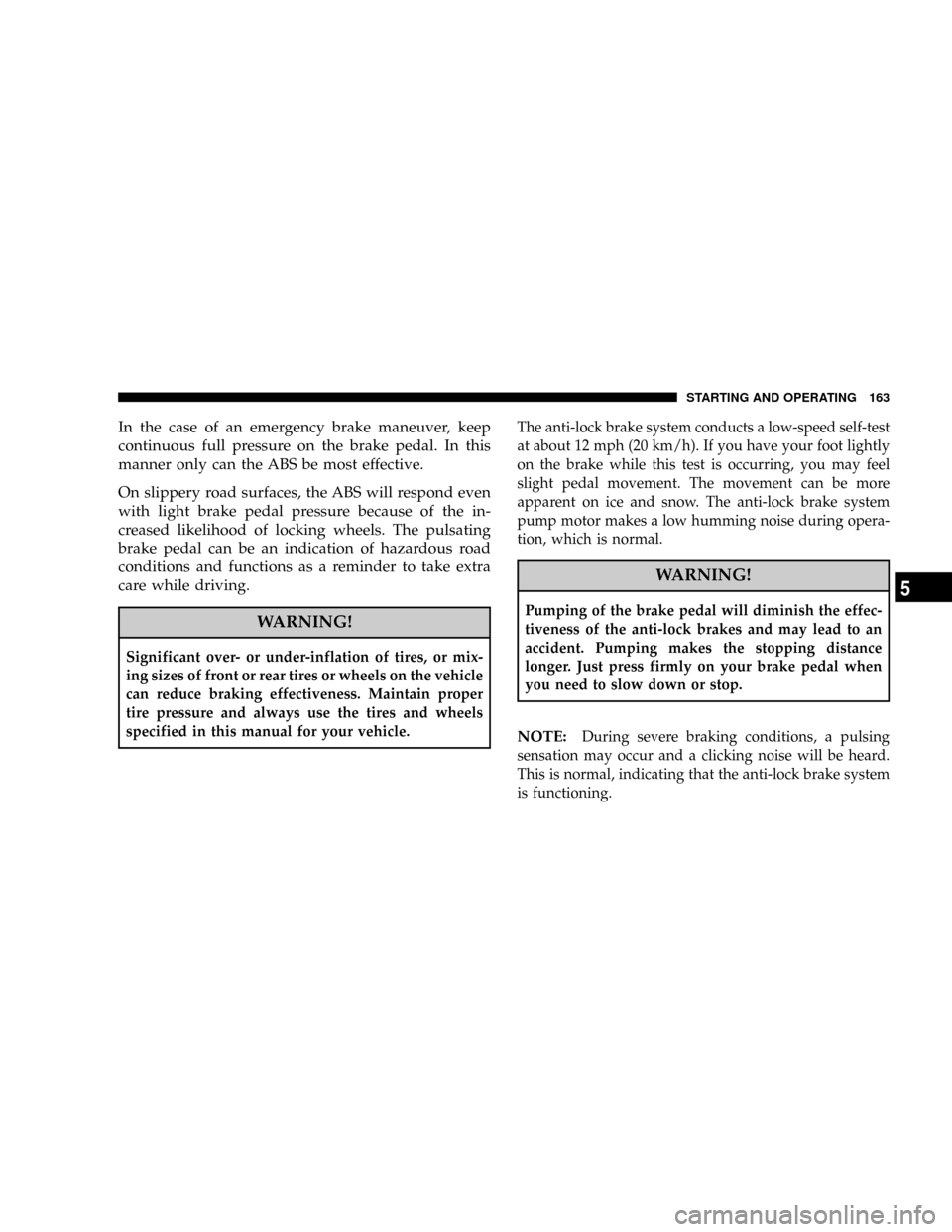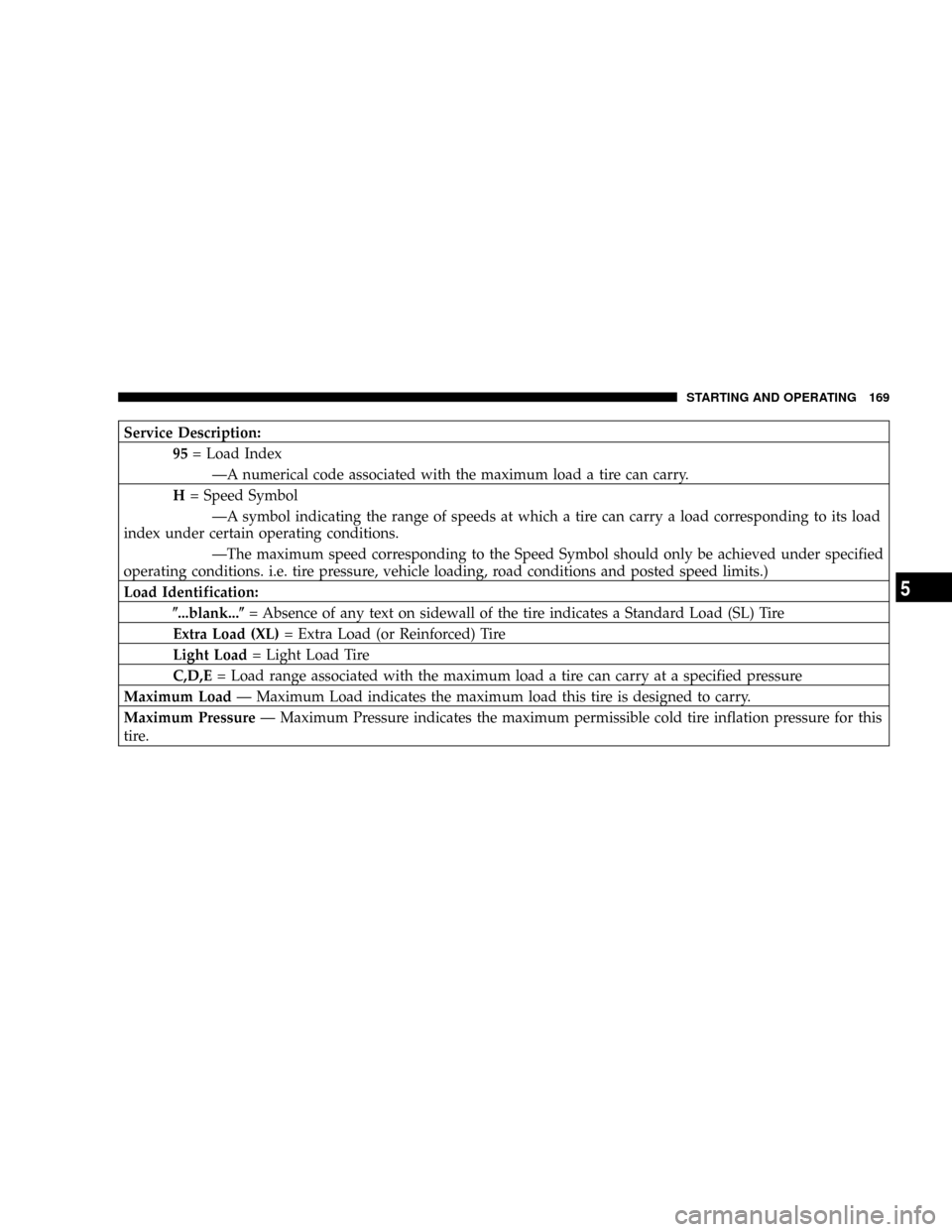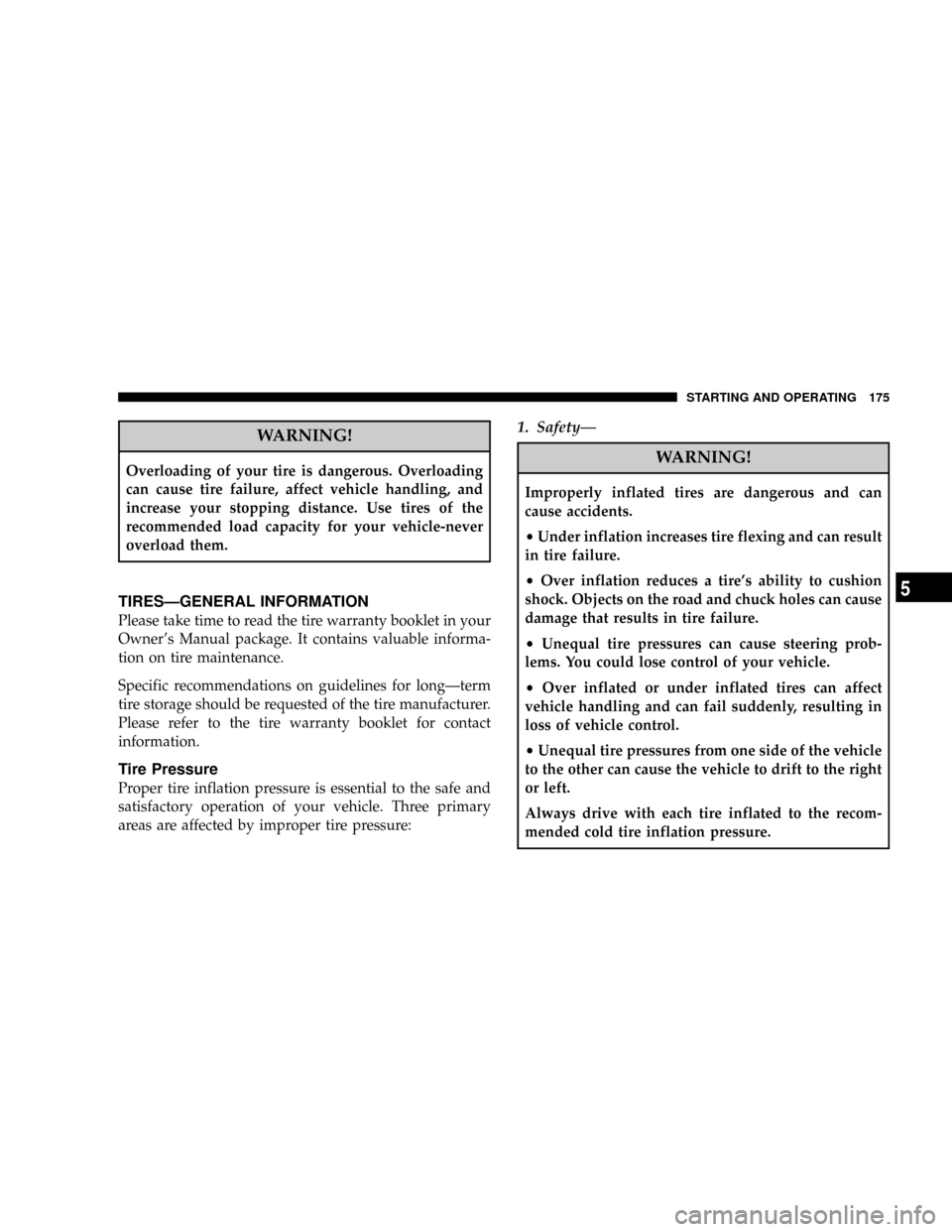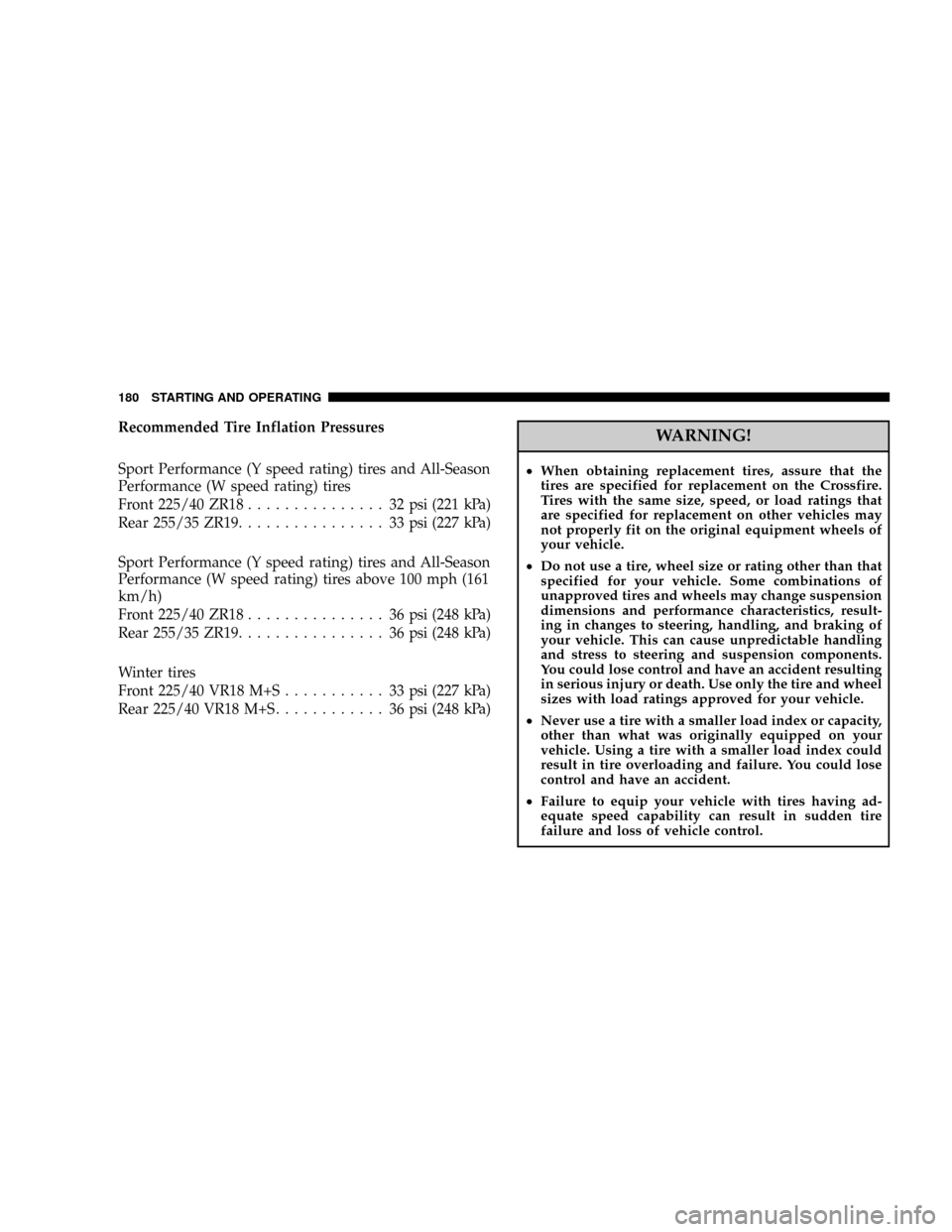tire pressure CHRYSLER CROSSFIRE 2007 1.G User Guide
[x] Cancel search | Manufacturer: CHRYSLER, Model Year: 2007, Model line: CROSSFIRE, Model: CHRYSLER CROSSFIRE 2007 1.GPages: 299, PDF Size: 8.26 MB
Page 163 of 299

In the case of an emergency brake maneuver, keep
continuous full pressure on the brake pedal. In this
manner only can the ABS be most effective.
On slippery road surfaces, the ABS will respond even
with light brake pedal pressure because of the in-
creased likelihood of locking wheels. The pulsating
brake pedal can be an indication of hazardous road
conditions and functions as a reminder to take extra
care while driving.
WARNING!
Significant over- or under-inflation of tires, or mix-
ing sizes of front or rear tires or wheels on the vehicle
can reduce braking effectiveness. Maintain proper
tire pressure and always use the tires and wheels
specified in this manual for your vehicle.The anti-lock brake system conducts a low-speed self-test
at about 12 mph (20 km/h). If you have your foot lightly
on the brake while this test is occurring, you may feel
slight pedal movement. The movement can be more
apparent on ice and snow. The anti-lock brake system
pump motor makes a low humming noise during opera-
tion, which is normal.
WARNING!
Pumping of the brake pedal will diminish the effec-
tiveness of the anti-lock brakes and may lead to an
accident. Pumping makes the stopping distance
longer. Just press firmly on your brake pedal when
you need to slow down or stop.
NOTE:During severe braking conditions, a pulsing
sensation may occur and a clicking noise will be heard.
This is normal, indicating that the anti-lock brake system
is functioning.
STARTING AND OPERATING 163
5
Page 167 of 299

TIRE SAFETY INFORMATION
Tire Markings
Tire Sizing Chart
NOTE:
P(Passenger)-Metric tire sizing is based on U.S.
design standards. P-Metric tires have the letter ªPº
molded into the sidewall preceding the size designation.
Example: P215/65R15 95H.
NOTE:European Metric tire sizing is based on Euro-
pean design standards. Tires designed to this standard
have the tire size molded into the sidewall beginning
with the section width. The letter9P9is absent from this
tire size designation. Example: 215/65R15 96H.
NOTE:LT(Light Truck)-Metric tire sizing is based on
U.S. design standards. The size designation for LT-Metric
tires is the same as for P-Metric tires except for the letters
ªLTº that are molded into the sidewall preceding the size
designation. Example: LT235/85R16.
NOTE:Temporary Spare tires are high pressure com-
pact spares designed for temporary emergency use only.
Tires designed to this standard have the letter ªTº
molded into the sidewall preceding the size designation.
Example: T145/80D18 103M.
NOTE:High Flotation tire sizing is based on U.S.
design standards and begins with the tire diameter
molded into the sidewall. Example: 31x10.5 R15 LT.
STARTING AND OPERATING 167
5
Page 169 of 299

Service Description:
95= Load Index
ÐA numerical code associated with the maximum load a tire can carry.
H= Speed Symbol
ÐA symbol indicating the range of speeds at which a tire can carry a load corresponding to its load
index under certain operating conditions.
ÐThe maximum speed corresponding to the Speed Symbol should only be achieved under specified
operating conditions. i.e. tire pressure, vehicle loading, road conditions and posted speed limits.)
Load Identification:
(...blank...(= Absence of any text on sidewall of the tire indicates a Standard Load (SL) Tire
Extra Load (XL)= Extra Load (or Reinforced) Tire
Light Load= Light Load Tire
C,D,E= Load range associated with the maximum load a tire can carry at a specified pressure
Maximum LoadÐ Maximum Load indicates the maximum load this tire is designed to carry.
Maximum PressureÐ Maximum Pressure indicates the maximum permissible cold tire inflation pressure for this
tire.
STARTING AND OPERATING 169
5
Page 171 of 299

Tire Loading and Tire Pressure
Tire Placard Location
NOTE:
Some vehicles have a ªTire and Loading Infor-
mationº placard located on the driver's side ªBº pillar.
Tire and Loading Information Placard
This placard tells you important information about:
1. the number of people that can be carried in the vehicle
2. the total weight your vehicle can carry
3. the tire size designed for your vehicle
4. the cold tire inflation pressures for the front, rear and
spare tires.
STARTING AND OPERATING 171
5
Page 172 of 299

Loading
The vehicle maximum load on the tire must not exceed
the load carrying capacity of the tire on your vehicle. You
will not exceed the tire's load carrying capacity if you
adhere to the loading conditions, tire size and cold tire
inflation pressures specified on the Tire and Loading
Information placard and the Vehicle Loading section of
this manual.
NOTE:Under a maximum loaded vehicle condition,
gross axle weight ratings (GAWR's) for the front and rear
axles must not be exceeded. For further information on
GAWR's, vehicle loading and trailer towing, see the
Vehicle Loading section of this manual.To determine the maximum loading conditions of your
vehicle, locate the statement ªThe combined weight of
occupants and cargo should never exceed XXX kg or XXX
lbs.º or ªVehicle Capacityº on the Tire and Loading
Information placard. The combined weight of occupants,
cargo/luggage and trailer tongue weight (if applicable)
should never exceed the weight referenced here.
Steps for Determining Correct Load Limit
1. Locate the statement ªThe combined weight of occu-
pants and cargo should never exceed XXX poundsº or
ªVehicle Capacityº on your vehicle's placard.
2. Determine the combined weight of the driver and
passengers that will be riding in your vehicle.
3. Subtract the combined weight of the driver and pas-
sengers from XXX kilograms or XXX pounds.
172 STARTING AND OPERATING
Page 175 of 299

WARNING!
Overloading of your tire is dangerous. Overloading
can cause tire failure, affect vehicle handling, and
increase your stopping distance. Use tires of the
recommended load capacity for your vehicle-never
overload them.
TIRESÐGENERAL INFORMATION
Please take time to read the tire warranty booklet in your
Owner's Manual package. It contains valuable informa-
tion on tire maintenance.
Specific recommendations on guidelines for longÐterm
tire storage should be requested of the tire manufacturer.
Please refer to the tire warranty booklet for contact
information.
Tire Pressure
Proper tire inflation pressure is essential to the safe and
satisfactory operation of your vehicle. Three primary
areas are affected by improper tire pressure:
1. SafetyÐ
WARNING!
Improperly inflated tires are dangerous and can
cause accidents.
²Under inflation increases tire flexing and can result
in tire failure.
²Over inflation reduces a tire's ability to cushion
shock. Objects on the road and chuck holes can cause
damage that results in tire failure.
²Unequal tire pressures can cause steering prob-
lems. You could lose control of your vehicle.
²Over inflated or under inflated tires can affect
vehicle handling and can fail suddenly, resulting in
loss of vehicle control.
²Unequal tire pressures from one side of the vehicle
to the other can cause the vehicle to drift to the right
or left.
Always drive with each tire inflated to the recom-
mended cold tire inflation pressure.
STARTING AND OPERATING 175
5
Page 176 of 299

2. EconomyÐ
Improper inflation pressures can cause uneven wear
patterns to develop across the tire tread. These abnormal
wear patterns will reduce tread life resulting in a need for
earlier tire replacement. Underinflation also increases tire
rolling resistance and results in higher fuel consumption.
3. Ride Comfort and Vehicle StabilityÐ
Proper tire inflation contributes to a comfortable ride.
Overinflation produces a jarring and uncomfortable ride.
Tire Inflation Pressures
The proper cold tire inflation pressure for passenger cars
is listed on either the face of the driver's door or the
driver's side ªBº pillar.The pressure should be checked and adjusted as well as
inspecting for signs of tire wear or visible damage at least
once a month. Use a good quality pocket-type gauge to
check tire pressure. Do not make a visual judgement
when determining proper inflation. Radial tires may look
properly inflated even when they are underinflated.
Tire Placard Orientation tread act
176 STARTING AND OPERATING
Page 177 of 299

CAUTION!
After inspecting or adjusting the tire pressure always
reinstall the valve stem cap±if equipped. This will
prevent moisture and dirt from entering the valve
stem, which could damage the valve stem.
Inflation pressures specified on the placard are always
ªcold tire inflation pressureº. Cold tire inflation pressure
is defined as the tire pressure after the vehicle has not
been driven for at least 3 hours, or driven less than 1 mile
(1 km) after a 3 hour period. The cold tire inflation
pressure must not exceed the maximum inflation pres-
sure molded into the tire side wall.
Check tire pressures more often if subject to a wide range
of outdoor temperatures, as tire pressures vary with
temperature changes.
Tire pressures change by approximately 1 psi (7 kPa) per
12É F (7É C) of air temperature change. Keep this in mind
when checking tire pressure inside a garage especially in
the winter.Example: If garage temperature = 68É F (20É C) and the
outside temperature = 32É F (0É C) then the cold tire
inflation pressure should be increased by 3 psi (21 kPa),
which equals 1 psi (7 kPa) for every 12É F (7É C) for this
outside temperature condition.
Tire pressure may increase from 2 to 6 psi (13 to 40 kPa)
during operation. DO NOT reduce this normal pressure
build up or your tire pressure will be too low.
Tire Pressures for High Speed Operation
The manufacturer advocates driving at safe speeds
within posted speed limits. Where speed limits or condi-
tions are such that the vehicle can be driven at high
speeds, maintaining correct tire inflation pressure is very
important. Increased tire pressure and reduced vehicle
loading may be required for high speed vehicle opera-
tion. Refer to original equipment or an authorized tire
dealer for recommended safe operating speeds, loading
and cold tire inflation pressures.
STARTING AND OPERATING 177
5
Page 179 of 299

Tread Wear Indicators
Tread wear indicators are in the original equipment tires
to help you in determining when your tires should be
replaced.
These indicators are molded into the bottom of the tread
grooves and will appear as bands when the tread depth
becomes 1/16 inch (2 mm). When the indicators appear
in 2 or more adjacent grooves, the tire should be replaced.
Many states have laws requiring tire replacement at this
point.
Replacement Tires
The tires on your new vehicle provide a balance of many
characteristics. They should be inspected regularly for
wear and correct cold tire inflation pressure. The manu-
facturer strongly recommends that you use tires equiva-
lent to the originals in size, quality and performance
when replacement is needed (see the paragraph on tread
wear indicators). Refer to the Tire and Loading Informa-
tion placard for the size designation of your tire. The
service description and load identification will be found
on the original equipment tire. Failure to use equivalent
replacement tires may adversely affect the safety, han-
dling, and ride of your vehicle. We recommend that you
contact your original equipment or an authorized tire
dealer with any questions you may have on tire specifi-
cations or capability.
STARTING AND OPERATING 179
5
Page 180 of 299

Recommended Tire Inflation Pressures
Sport Performance (Y speed rating) tires and All-Season
Performance (W speed rating) tires
Front 225/40 ZR18............... 32psi(221 kPa)
Rear 255/35 ZR19................ 33psi(227 kPa)
Sport Performance (Y speed rating) tires and All-Season
Performance (W speed rating) tires above 100 mph (161
km/h)
Front 225/40 ZR18............... 36psi(248 kPa)
Rear 255/35 ZR19................ 36psi(248 kPa)
Winter tires
Front 225/40 VR18 M+S........... 33psi(227 kPa)
Rear 225/40 VR18 M+S............ 36psi(248 kPa)WARNING!
²When obtaining replacement tires, assure that the
tires are specified for replacement on the Crossfire.
Tires with the same size, speed, or load ratings that
are specified for replacement on other vehicles may
not properly fit on the original equipment wheels of
your vehicle.
²Do not use a tire, wheel size or rating other than that
specified for your vehicle. Some combinations of
unapproved tires and wheels may change suspension
dimensions and performance characteristics, result-
ing in changes to steering, handling, and braking of
your vehicle. This can cause unpredictable handling
and stress to steering and suspension components.
You could lose control and have an accident resulting
in serious injury or death. Use only the tire and wheel
sizes with load ratings approved for your vehicle.
²Never use a tire with a smaller load index or capacity,
other than what was originally equipped on your
vehicle. Using a tire with a smaller load index could
result in tire overloading and failure. You could lose
control and have an accident.
²Failure to equip your vehicle with tires having ad-
equate speed capability can result in sudden tire
failure and loss of vehicle control.
180 STARTING AND OPERATING